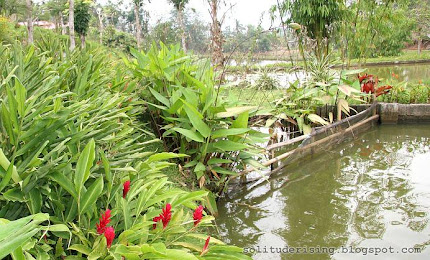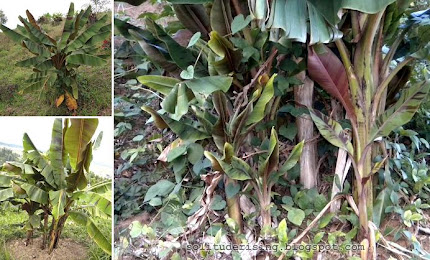"From the outside looking in, you can never understand it. From the inside looking out, you can never explain it."
unknown
If there is one very important feature that our farm lacks, that's privacy. Despite the
high wall, neighbors on the other side of the street still have an unobstructed view of the goings-on inside the farm, as you can see from the picture below. This is because the ground on the other side of the street is elevated.

A man looking inside the farm while waiting for a public transportation to pass by.
There are a couple of viable options for this much sought for privacy:
- Make the concrete wall taller. This would work but may pose danger to life, limb or property especially if the wall is toppled down by a strong storm. The wall is already 8-foot tall.
- Plant more trees inside the property, parallel to the wall and the road. But it will take many years and maybe even decades before they grow past the height of the existing wall. They could also get knocked down by a powerful storm.
The second option is more feasible but instead of trees I chose bamboos because they are fast growers. My father computed that it would take around 150 clumps of bamboos, spaced 3 meters apart to provide a decent privacy screen.
First, I need a type of clumping bamboo that will grow tall, around 15 meters high. There are several options like the Giant Bamboo (
Dendrocalamus asper), Java Black Bamboo (
Gigantochloa atroviolacea), Columbian Thorny Bamboo (
Guadua angustifolia [technically not a pure clumper]), etc. After studying all the options I chose Oldham Bamboo (
Bambusa oldhamii) because of its erect culms and short branches, it looks neat, dignified and beautiful.

Oldham Bamboo seedlings purchased from the bamboo store.
Next, I need to find a reputable plant store that knows what it sells or else I might end up with the wrong plant again. The stores my parents inquired at didn't even know what "Oldham Bamboo" is. Finally I found a store that specializes in bamboos only and they have Oldham! All their plants are labeled to avoid confusion. You can even inspect the mother plants if you go to their farm. I suspect their plants would be expensive since they have a decent website, an office and a nursery in Makati, the country's premier business district.
My mother called their office and talked to the manager. For some reason she was told of the wrong price. Based on this incorrect information I computed the total amount needed for 150 seedlings and then funded this project. With my go-signal, my mother called the store to confirm an order of 150 seedlings of Oldham Bamboo.
A few days before the set pick-up date, we were informed that they gave us the wrong price and that the actual price was actually 60% more. Now this is a possible deal breaker. The total price went up to ₱60,000.00 (US$1,430.00)
1, way above the initial total amount. Then another surprise - currently they only have 20 seedlings of the bamboos we ordered. What the heck?!!

Columbian Thorny Bamboo (Guadua angustifolia) seedlings.
Anyway, since we can no longer afford to pay for the 150 seedlings and since they don't have that many either, we took the 20 they have, bought a couple of some other bamboo species and called it a day.
Just another quirky adventure on our quest for a little privacy.
P.S.:
I did not mention the name of the store since it may look like an endorsement. But if you need to know, just send an e-mail and I will gladly share their info.
----------
1 Exchange rate: US$1.00 : PH₱42.00






















































